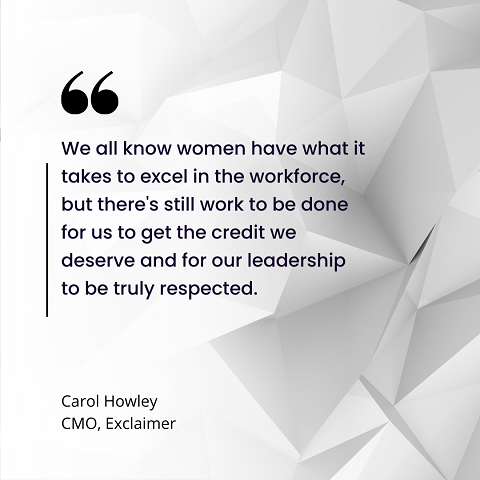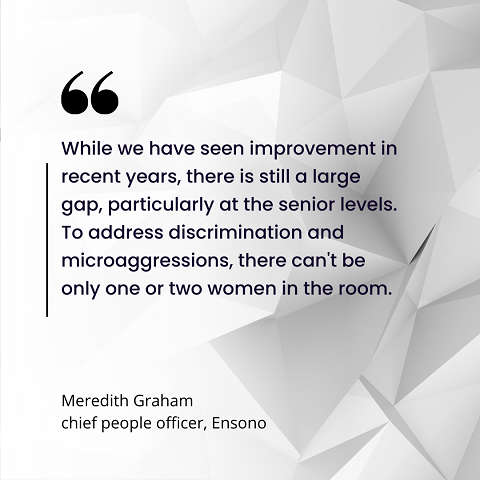While women working in IT have made strides, significant disparities and areas for improvement persist, according to Ensono's 2024 Speak Up survey, conducted among 1,500 female tech employees in the United States, UK, and India.
Despite advancements, half of the surveyed women still grapple with balancing caregiving responsibilities alongside in-person work, with a quarter reporting discomfort or unsafety due to microaggressions or discrimination in the workplace.
However, amidst these challenges, there's a glimmer of optimism. The survey revealed a remarkable 93% of respondents acknowledging an improvement in gender equity and inclusion over the past year.

Notably, positive experiences were observed across various work settings, with in-person and hybrid employees highlighting benefits such as stronger colleague relationships and improved work-life boundaries.
Remote work also emerged as an empowering force, with 97% of respondents experiencing increased opportunities in the tech job market and 95% reporting enhanced work-life balance due to remote arrangements.
Female Mentors Providing GenAI Guidance
Women are also making significant strides in leading discussions around generative AI — nearly three quarters (73%) of respondents said they have female mentors at work who provide guidance and expertise on generative AI.
Of those who have received internal trainings on generative AI usage, 35% said these were led by women, and an additional 36% said trainings were led by an even mix of men and women.
Moreover, the prevalence of female mentors providing guidance on generative AI signals a promising trend, particularly in India.
However, challenges persist, with nearly a fifth of female tech employees considering leaving their current positions within the year.
The survey also underscored critical areas for improvement, including:
- inadequate support for caregivers
- instances of microaggressions and discrimination
- feelings of isolation, particularly among remote workers
To address these challenges, employers must prioritize solutions such as investing in childcare support, fostering inclusive work environments, and bridging the knowledge gap in emerging technologies like generative AI.
The survey results indicated that flexibility in work hours and remote work opportunities emerge as crucial strategies to retain top talent.
Inclusion Key to Combating Microaggressions
Caroline Carruthers, CEO of data consulting firm Carruthers and Jackson, recalls when she first joined an IT department 30 years ago, saying "significant strides" have been made that have undoubtedly placed women in a better position today.
"It's really crucial to recognize these achievements and appreciate the collective effort that brought us here," she said. "However, there is still clear room for improvement."
One persistent challenge that women face, according to Carruthers, is the tendency for many organizations to hire individuals who mirror their own characteristics, resulting in a lack of diversity.
"Diversity can be exemplified by the diversity of thought and perspective within a team," she explained.
Therefore, the goal should be to assemble teams with diverse backgrounds and perspectives, creating an environment where differences are valued and contribute to high-performance outcomes.
Addressing microaggressions is another area where Carruthers said progress is needed.
"Often, individuals may not even realize when they commit microaggressions, highlighting the need for multiple voices to address the behavior," she said. "By collectively pointing out these instances, we can demonstrate that they are not isolated incidents but rather systemic issues that require attention."

It's crucial to cultivate a culture where everyone feels empowered to speak up against microaggressions and contribute to a more inclusive workplace, she added.
Correcting for Underrepresentation of Women in Tech
The biggest challenge continues to be the underrepresentation of women in the tech industry, according to Meredith Graham, chief people officer at Ensono.
"While we have seen improvement in recent years, there is still a large gap, particularly at the senior levels," she said. "To address discrimination and microaggressions, there can't be only one or two women in the room."
Graham admits this isn't going to change overnight, and to create a safe work environment for women, there needs to be a collective effort within leadership to continue to create inclusive workplaces and to not tolerate discrimination at any level.
"There are several strategies, but the two I have seen success with are women's mentorship programs and ensuring that women are considered for leadership positions," she said.
Mentorship programs can encourage and foster growth as well as help women overcome any self-doubt when they have experienced senior mentors guiding them.
"We've all had challenges throughout our careers, and learning that those challenges can be overcome is important for continued growth," Graham said.
Leaders must also ensure women are considered for leadership roles when they are available — creating equal opportunities and breaking down biases is important.

Enhancing Inclusivity, Accessibility
Lynn Dohm, executive director of Women in Cybersecurity (WiCys), said that while her organization celebrates the strides taken to include more underrepresented groups, she's keenly aware that much work is left to enhance accessibility and inclusivity in the cybersecurity landscape.
"With 3.9 million jobs open in cybersecurity and only 24-26% representation from women, the gap is clear," she explained.
Organizations play a pivotal role in this journey, not just bridging the gap but also ensuring that cybersecurity is enriched by diverse perspectives and talents, according to Dohm.
"We're at a critical point where industry needs to invest in the cybersecurity workforce, not just to build the pipeline but to avoid the leaky pipe as well," Dohm added.
Tech companies can create a more inclusive workplace by starting with inclusive language and learning how to support women in cybersecurity, she said.
Effective strategies include:
- taking intentional steps to address inclusion challenges,
- focusing on leadership's role in promoting diversity, and
- prioritizing career growth and professional development for all employees.
"Recognizing and investing in women's advancement not only supports their individual career paths but also signals a commitment to nurturing a diverse and dynamic workforce," Dohm said.
When it comes to job descriptions, Carruthers said it's clear that many still resort to copy-and-pasting from previous templates rather than focusing on the actual skills required.
"Studies have shown a disparity in how men and women perceive job descriptions, with men being more inclined to apply even if they don't meet all the criteria, whereas women tend to self-select out more quickly," she said.
Excessive or irrelevant skills listed in job descriptions can inadvertently deter women from applying.
"Empowering women to stand up for themselves is crucial, but it's equally important to ensure that job descriptions are reflective of the actual job demands," Carruthers said.
A second crucial strategy is to simply listen to and understand the needs of women, and approach this in a way that makes people feel comfortable and open, she said.
"Providing a platform for anonymous feedback can help create a safe space for honest communication," she added.
Stereotypes Hamper Women's Career Paths
Stereotypes tied to women — for example, being seen as caregivers or helpers — can significantly impede their perception and advancement within the tech industry, according to Carol Howley, CMO of Exclaimer.
She said these stereotypes can result in microaggressions such as "man-splaining" or subtle comments that undercut expertise.
"We all know women have what it takes to excel in the workforce, but there's still work to be done for us to get the credit we deserve and for our leadership to be truly respected," Howley says.
Gender pay gaps and the lack of women in senior tech roles are still issues facing the industry, Howley said, agreeing with Graham that mentorship opportunities are crucial to empower women in their careers.
"Bias training is a must for shedding light on unconscious stereotypes in STEM, and setting out clear consequences for workplace misconduct really helps create a safer, more inclusive space for women," Howley added.
From her perspective, the secret to retaining female talent lies in making sure they like working where they are — where they feel comfortable and can really grow.
This includes having a diverse team and a culture that includes everyone, steering clear of those old-school "bro culture" vibes.
"Throwing in flexible policies and perks like parental leave or child-care options can really boost workplace appeal for women," Howley said.
Carruthers added that, post-COVID-19, flexible working arrangements and work-life balance are increasingly valued by everyone.
"It's essential to ensure that such flexibility is accessible to all individuals," she said. "Rather than viewing it as a gender-specific issue, we should focus on making flexible working options available to both men and women."
This approach promotes a more equitable work environment where everyone can balance their professional and personal responsibilities effectively.
Limiting flexible working arrangements to women implies outdated gender roles and fails to acknowledge the needs and preferences of all employees, Carruthers stressed.
"It is important to implement policies and practices that cater to the needs of everyone, regardless of gender," she said.
About the author
 Nathan Eddy is a freelance writer for ITPro Today. He has written for Popular Mechanics, Sales & Marketing Management Magazine, FierceMarkets, and CRN, among others. In 2012 he made his first documentary film, The Absent Column. He currently lives in Berlin.
Nathan Eddy is a freelance writer for ITPro Today. He has written for Popular Mechanics, Sales & Marketing Management Magazine, FierceMarkets, and CRN, among others. In 2012 he made his first documentary film, The Absent Column. He currently lives in Berlin.





